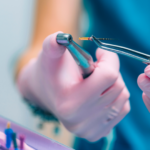Invisalign FAQ: Your Top Questions Answered!

Invisalign vs. Smile Direct: What Is The Difference?
July 31, 2024
How To Know If You Need a Root Canal
September 26, 2024Invisalign FAQ: Your Top Questions Answered!
 Dr. Prashant Rao, DDS, a Charlotte native and NYU-trained dentist, specializes in esthetics, dental implants, and preventative dentistry.
Dr. Prashant Rao, DDS, a Charlotte native and NYU-trained dentist, specializes in esthetics, dental implants, and preventative dentistry.
Key Takeaways:
Invisalign:
It is a clear aligner system used to straighten teeth without traditional braces.
Clear Aligners:
The aligners are custom-made to fit comfortably and can be removed for eating and cleaning.
Treatment Process:
Invisalign treatment time and cost vary, but it is generally a good option for those with mild to moderate orthodontic issues and good oral health.
Invisalign has revolutionized orthodontics with a modern, discreet alternative to traditional braces. This guide covers everything you need to know, from how Invisalign works to why it’s a great choice and who it suits best.
We’ll also dive into how long the treatment takes, what you should expect to pay, and the steps involved in getting started. Whether you’re interested in the subtle look of the aligners or their comfort, our Invisalign FAQ will answer your top questions and help you decide if Invisalign is the right choice for you!
What Is Invisalign Exactly?
Invisalign is a popular choice for straightening teeth without the metal braces you might be used to seeing. Instead of traditional brackets and wires, Invisalign uses clear, almost invisible aligners, making them a more discreet option.
These aligners are custom-made to fit your teeth perfectly, thanks to advanced 3D imaging technology. This ensures that each aligner moves your teeth in small, precise steps, leading to a beautifully straight smile.
A major advantage of Invisalign is that the aligners are removable, so you can enjoy your favorite foods without restrictions and maintain good oral hygiene by easily brushing and flossing. Additionally, the smooth plastic design provides greater comfort and less irritation than traditional metal braces.
How Does Invisalign Work?
Invisalign is all about creating a personalized treatment plan to straighten your teeth without using metal braces. It starts with a 3D scan of your teeth, which helps in making a set of custom aligners designed to fit your teeth and gradually move them into the right position.
Here’s a straightforward look at the Invisalign process:
Initial Consultation
It all kicks off with a visit to your dentist, who will assess your dental situation and talk through your goals and expectations.
3D Imaging
Next, 3D imaging technology captures detailed images of your teeth. These images help create a customized treatment plan.
Aligner Creation
Using this plan, a series of aligners are made from special materials that are both comfortable and effective.
Regular Check-ups
You’ll have periodic check-ups to make sure everything is progressing well and to make any needed adjustments.
Wearing Aligners
As you move through the aligners, your teeth gradually shift into their ideal positions, giving you a smooth and discreet way to achieve a great smile.
What Are the Benefits of Invisalign?
Invisalign is a popular choice for orthodontic treatment because of its clear aligners that are both discrete and comfortable. Here’s why many people opt for Invisalign:
Discreet Appearance
Invisalign aligners are nearly invisible, so you can straighten your teeth without anyone noticing. Unlike metal braces, which are obvious and can make some people self-conscious, these clear aligners blend into your smile, making them a great option for both adults and teens.
Invisalign is Removable
One of the best features of Invisalign is that the aligners are removable. This means you can take them out to eat and drink, so you don’t have to avoid any of your favorite foods. It also makes brushing and flossing easier, helping you maintain good oral hygiene without the hassle of traditional braces.
Aligners are Comfortable in Comparison to Traditional Braces
Invisalign aligners are made from smooth, flexible plastic, which means they’re much more comfortable than metal braces. There are no wires or brackets to cause irritation, and you can remove the aligners to eat and clean them. This comfort makes the treatment more enjoyable and less disruptive to your daily life.
No Food Restrictions
Speaking of food, with Invisalign, you can eat whatever you like without worrying about damaging brackets or wires! Whether you’re at a social event or just enjoying a meal, you can remove your aligners and eat freely. This flexibility adds to the overall convenience of the treatment.
Who Is a Good Candidate for Invisalign?
Curious if Invisalign might be the right fit for you? The following Invisalign FAQ will help you understand if this modern orthodontic treatment aligns with your needs:
Mild to Moderate Orthodontic Issues
A fantastic solution for mild to moderate orthodontic problems is Invisalign. With aligners that are specifically designed to progressively move your teeth into the proper position, it provides a comfortable method of straightening teeth. Many issues, including overcrowding, biting issues, and spacing, can be effectively treated with this approach.
Invisalign is loved for its convenience and subtlety. Unlike traditional braces, it’s clear, smooth plastic aligners are gentle on your teeth and can be easily removed for eating and cleaning. If you’re looking for a discreet and effective way to straighten your teeth, Invisalign could be the perfect fit.
Good Oral Health Habits
Keeping up with good oral health is key if you’re thinking about Invisalign. It’s not just about making your smile look great; a healthy mouth helps the aligners work effectively and prevents issues like tooth decay and gum disease during treatment.
To make the most of your Invisalign procedure, regular brushing and flossing are a must. Don’t skip your routine dental check-ups—they help catch any potential problems early on. Also, avoiding sticky or sugary foods is not necessary (as we mentioned, there are no food restrictions with Invisalign) this is just advisable. By taking these steps, you’ll set yourself up for a successful treatment and a smile that truly shines.
Commitment to Being Consistent With Wearing Aligners
If you’re going for Invisalign, it’s crucial to stick to the plan and wear your aligners as directed. Following your dentist’s advice and keeping up with the treatment schedule is key to getting the best results. Wearing your aligners consistently, for at least 20 to 22 hours a day, ensures they work properly and helps you finish your treatment sooner!
To stay on track, try setting daily reminders so you don’t forget to put them in. Keeping the aligners in a visible spot can also serve as a good reminder. Using a tracking app or journal to note your progress might keep you motivated. By staying committed and working closely with your dentist, you’ll be on the path to a great smile.
How Long Does Invisalign Treatment Take?
The time it takes to complete Invisalign treatment can vary quite a bit, depending on a few key factors. On average, you’re looking at anywhere from 6 to 18 months, but this can change based on how complex your alignment issues are, your age, and your initial oral health. For example, more complex cases will naturally take longer to treat.
If you’re younger or have a developing jaw, you might see faster results compared to adults. Also, if you have existing dental issues like cavities or gum disease, this can extend the treatment time. To get a better idea of how long your Invisalign treatment will take, it’s best to have a consultation with your dentist.
Factors That Affect Treatment Time
One big factor is the complexity of your dental issues—more severe misalignments generally mean a longer treatment period. Another key element is how well you stick to the treatment plan. If you wear your aligners as directed and attend your follow-up appointments, you’re likely to see better and faster results.
Personal habits also play a role in how long your treatment will take. Things like smoking, not keeping up with oral hygiene, or skipping your aligners can slow down your progress. By keeping these factors in mind and staying committed to your treatment, you can set realistic expectations and actively contribute to achieving your best smile.
How Much Does Invisalign Cost?
The cost of Invisalign treatment can vary for a few different reasons, so it’s important to understand what influences the final price. One major factor is the complexity of the orthodontic issues you need to address. More severe misalignments might require a longer treatment period or additional aligners, which can increase the overall cost.
Insurance coverage also plays a role in how much you’ll end up paying out of pocket. Some insurance plans may cover part of the cost, but it’s important to check the details of your policy to know what’s included. Additionally, prices can differ depending on where you live, so it’s a good idea to compare costs at different clinics in your area. To get a clearer picture of what you’ll need to budget for, a detailed consultation with your dentist can help you understand these factors and plan accordingly.
What Factors Affect The Cost of Invisalign Treatment
The severity of your tooth misalignment determines how much Invisalign treatment costs. If your teeth are severely misaligned or you have complex bite disorders, you may need more thorough treatment. This often results in a higher expense since the aligners must be adjusted to treat these more complex difficulties properly.
Another factor that affects the price is the estimated duration of the treatment. Longer treatments generally mean more aligners and more visits to the dentist. Additionally, the number of aligners you need will also impact the cost. More aligners are typically required for more severe cases or longer treatment plans. So, the greater the complexity and duration of your treatment, the higher the potential cost.
Thinking Invisalign Might Be Right for You? Schedule Your Appointment with Cedar Walk Dentistry Today
If you found this Invisalign FAQ helpful and are curious whether Invisalign is the right choice for you, Cedar Walk Dentistry is here to help. Contact us today to schedule your consultation and start your Invisalign journey with us. Our team is ready to provide personalized advice and answer any additional questions that you might have!
Frequently Asked Questions
What is Invisalign and how does it work?
Invisalign is an orthodontic treatment that uses clear, removable aligners to gradually shift teeth into their desired positions. The aligners are custom-made for each patient and are worn for about 22 hours a day. They work by applying gentle pressure to the teeth, slowly moving them into alignment.
How long does Invisalign treatment take?
The duration of Invisalign treatment varies from person to person, depending on the complexity of their case. On average, it takes about 12-18 months for adults, and 18-24 months for teenagers to complete their Invisalign treatment.
Can Invisalign fix all types of orthodontic issues?
Invisalign can fix a wide range of orthodontic issues, including crowded teeth, gaps, overbites, underbites, and crossbites. However, severe cases may require traditional braces or other orthodontic treatments.
How often do I need to change my Invisalign aligners?
You will typically change to a new set of aligners every 1-2 weeks, depending on your treatment plan. This allows your teeth to gradually shift into their new positions.
Can I eat and drink with my Invisalign aligners on?
No. It is recommended to remove your aligners when eating or drinking anything other than water. This helps to prevent staining and damage to the aligners. Remember to brush your teeth before putting your aligners back in.
Is Invisalign treatment painful?
The majority of patients experience minimal discomfort with Invisalign treatment. You may feel some pressure or soreness when you first start wearing a new set of aligners, but this is a sign that the aligners are working and should subside within a few days.
Practice Recognitions
Recent Posts
- How Long Do Same-Day Crowns Last?
- Top Cosmetic Dental Procedures: Start 2025 With a New Smile
- What is a Zirconia Crown
- How To Know If You Need a Root Canal
- Invisalign FAQ: Your Top Questions Answered!
- Invisalign vs. Smile Direct: What Is The Difference?
- Itchy Gums: Causes, Relief, and Prevention
- The Benefits of Dental Implant Surgical Guides
- Wisdom Teeth Removed: 5 Signs You May Need to Remove Yours
- Tips For Wisdom Teeth Pain Relief: All You Need To Know




